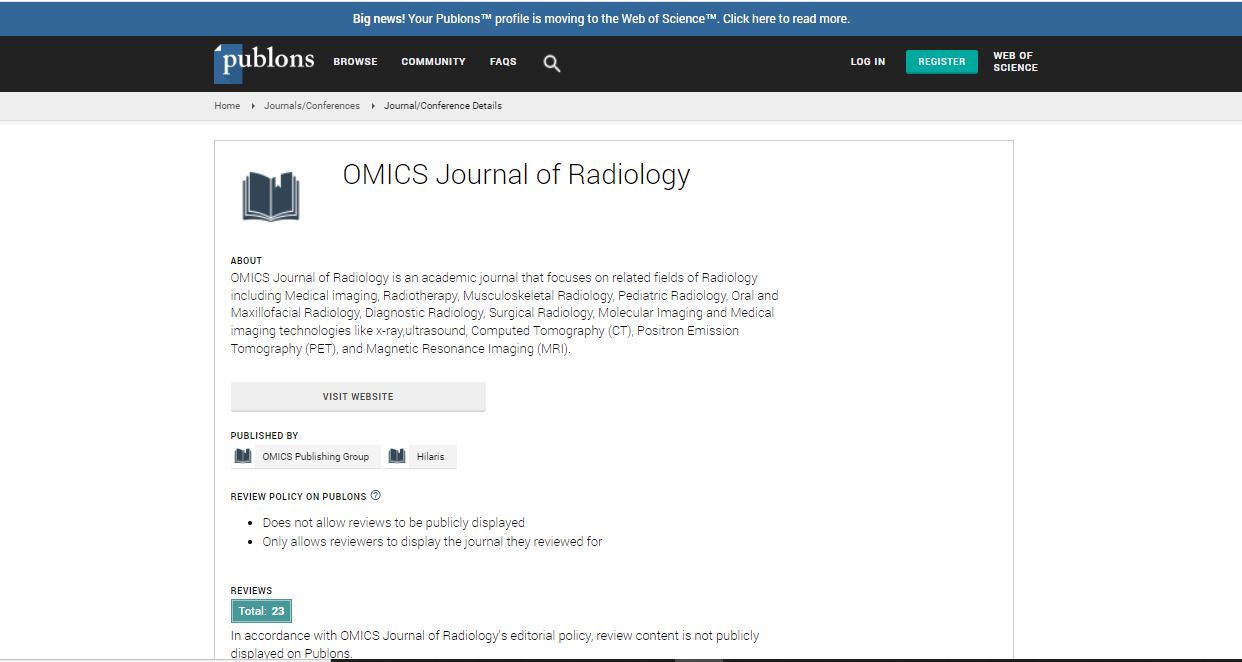Our Group organises 3000+ Global Conferenceseries Events every year across USA, Europe & Asia with support from 1000 more scientific Societies and Publishes 700+ Open Access Journals which contains over 50000 eminent personalities, reputed scientists as editorial board members.
Open Access Journals gaining more Readers and Citations
700 Journals and 15,000,000 Readers Each Journal is getting 25,000+ Readers
Google Scholar citation report
Citations : 551
Journal of Radiology received 551 citations as per Google Scholar report
Journal of Radiology peer review process verified at publons
Indexed In
- Index Copernicus
- Google Scholar
- Open J Gate
- Genamics JournalSeek
- ResearchBible
- Electronic Journals Library
- RefSeek
- Hamdard University
- EBSCO A-Z
- OCLC- WorldCat
- SWB online catalog
- Virtual Library of Biology (vifabio)
- Publons
- Geneva Foundation for Medical Education and Research
- ICMJE
Useful Links
Share This Page
Magnetic resonance imaging and post-processing analysis of flexor muscle in Pompe disease
2nd World Congress on Medical Imaging and Clinical Research
Ala Khasawneh
University of P�©cs, Hungary
ScientificTracks Abstracts: OMICS J Radiol
Abstract
Pompe disease is a rare multisystem genetic disorder that characterized by a deficiency of the lysosomal enzyme acid alphaglucosidase and cytoplasmic glycogen accumulation causing damage that leads to muscle weakness. This study aim is to evaluate the muscle MRI pattern of twelve adults with late onset Pompe disease and twelve sex- and age-matched healthy controls (Age range 19-59) for feature extraction which will be used to identify and classify functioning and non-functioning muscles. A training procedure was implemented using an Exercise Dynamometer device to stimulate the muscle for maximal contraction, MRI images data was used to compare the three flexor muscles in the lower limb function. MRI images data of biceps femoris (BF) muscle, Semitendinosus (ST) muscle, semimembranosus (SM) muscle before and after exercise (base, 30 min, 24 hours) was measured. We performed and quantified T2 relaxation data of flexor muscles, and all data analyzed using repeated measure ANOVA to compare within related groups of the independent variable time (Base, 30M, 24H). According to our results, the significantly lower T2 value in the ST muscle of controls was observed (base=43ms, 30min=48ms, 24h=43ms; P < 0.05), but the change in SM muscle and BF muscle were not significant. In patients, we detected significantly higher T2 value in SM muscle evolve over time (base=129ms, 30min=132ms, 24h=128ms; P < 0.05) compared to the controls, but ST muscle neither BF muscle doesn't show significant change. As a conclusion, we can say that in Pompe patients the SM muscle can only react to the exercise apparently and shows us an activity in affected muscle cells, compared to the BF and ST muscle not shown any activity, that�s mean perhaps the Pompe disease change the muscle cells structure to interact to the exercise.Biography
Ala Khasawneh is a Jordanian Doctor. He completed his Diploma in General Medicine (MD) and has been awarded the qualification of a Physician and title of Doctor of Medicine from National Pirogov Memorial Medical University. He worked in Basma Hospital, Jordan. Currently, he is a PhD fellow in Diagnostic Medical Imaging in Hungary. As a Doctor, his main interest is to create new pathways for improving health care.

 Spanish
Spanish  Chinese
Chinese  Russian
Russian  German
German  French
French  Japanese
Japanese  Portuguese
Portuguese  Hindi
Hindi 
